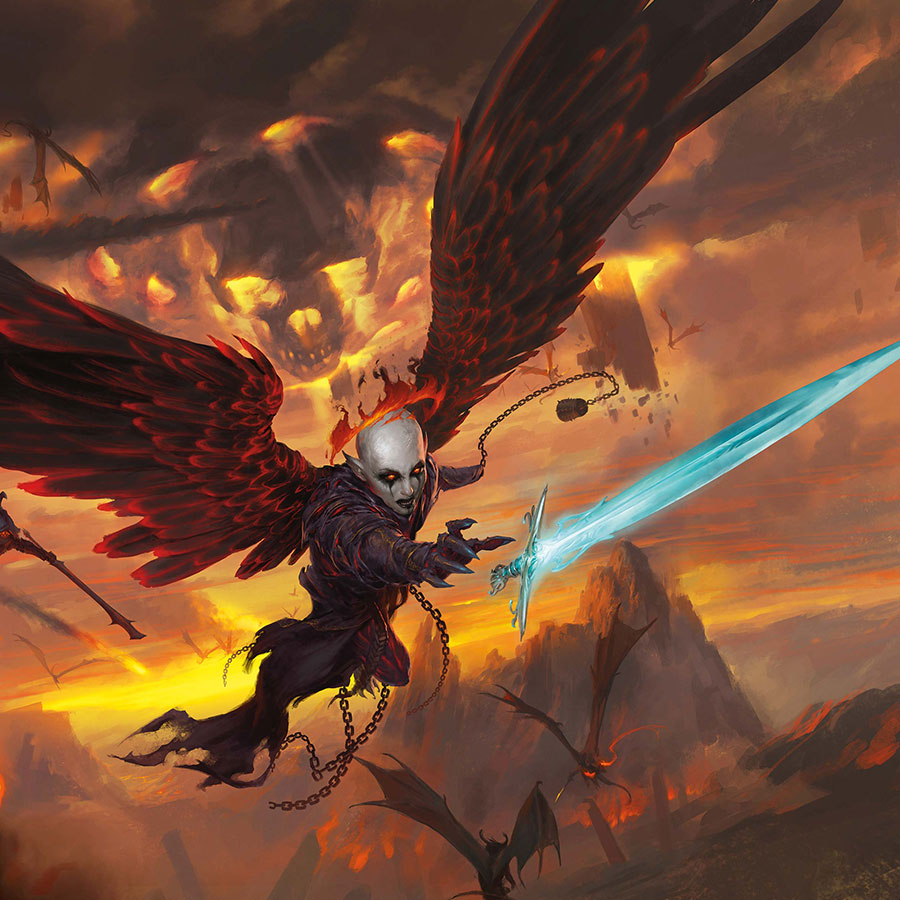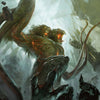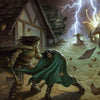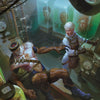How to Avoid Railroading in DnD

Written by Luke Hart
Storytelling is usually considered the holy grail of tabletop roleplaying games such as D&D; it’s something sacred whose importance supersedes every other consideration. We all want to know who the Big Bad is, what horrible end-of-world scheme they are up to, and then experience the challenges and victories of our characters as they set about stopping said Big Bad. This is the story. And, sometimes, it’s overrating.
Think about it. What’s one of the biggest COMPLAINTS you often see about D&D games? It’s the dreaded RAILROAD isn’t it? Okay, second to games failing apart because of scheduling, or toxic players or game masters ruining the game for everyone else—which is ironic because many of these horror stories feature narrators who STAY in the game for much longer than a rational person would. Either they enjoy suffering, or they’re just making up BS to score sweet sweet Reddit karma. Who knows…
Anyway, RAILROADING! You see, on the one hand we hold up STORYTELLING and the precious STORY as sacrosanct, and yet in the other hand we hold railroading as filthy, disgusting, and worthy of our deepest distain. And yet, they go hand in hand, really. That is, you can’t have one without the other. You see, our need for a cohesive ongoing story in a campaign is almost always what leads to railroading. And it especially leads to a LINEAR campaign, which many people conflate with RAILROADING, but they’re wrong.
My point is that having a central campaign story arc with a single Big Bad, the horrible thing they are doing, and then adventures where the characters try to stop them is what often leads us to railroads and linear adventures…which many players apparently hate.
So, do we just get rid of the story? Throw out storytelling? Kill the campaign story arc? Mmm…maybe?
So, today we’re talking about how to run a tabletop roleplaying game such as D&D WITHOUT a central campaign story arc; that is, a PLAYER-DIRECTED campaign. And I think we’ll find that it doesn’t KILL the story or remove storytelling from the game; instead, it makes the story more organic, pushes it more into the players’ hands instead of the game master’s, and minimizes that RAILROADY or LINEAR feel that many games have.
Watch or listen to this article by clicking the video below.
What does a player-directed game look like?
It’s a game where the characters are NOT concerned with the plot and plans of one central villain for the entire length of the campaign. Instead it’s a game where the characters have a series of mostly unrelated adventures where the only connecting thread may be the characters themselves.
In my Sword Coast Guards campaign, the characters were striving against Lord Paxton for the entire campaign, thwarting his minions, stopping his evil plans, until they finally fought and defeated him. THAT campaign had a central campaign story arc.
However, what if Lord Paxton was just one adventure, and then for the other adventures they were just roaming up and down the Sword Coast, righting wrongs, kicking a variety of butts, sometimes just delving a dungeon for kicks, and otherwise doing stuff that was not all interconnected into one grand story. THAT would be a game WITHOUT a central campaign story arc.
If you’ve every watched an action-adventure sci-fi show from before the late ‘90s, like Knight Rider, the A-Team, Star Trek, or MacGuyver, you already know how this campaign works. Each episode has a different adventure the protagonists go on, but none of the episodes are really related.
However, for those of you who think this style of game gives you an excuse to stop prepping and just wing it: you’re wrong. This kind of game is NOT the GM winging it. Many times, a game WITHOUT a central arc can be MORE work for the GM. Now, it depends on how you run such a game, because as we’ll discuss in a moment, there are a few different ways you can games without central story arcs.
More than anything else, a campaign without a central story arc—you know, we’re going to have to name this term; let’s just call it a player-directed campaign. That describes the concept fairly well, I think. So, more than anything else, a player-directed campaign is about maximizing options for the players and their characters.
Of course, this type of game may not be for everyone. You might find that you hate it, and that you prefer having a central story arc even if you are then forced to cry online about being railroaded.
So, why might a player-directed campaign NOT be a good choice for you?
First, for a lot of TTRPG players, especially in recent years, there is simply an EXPECTATION that a campaign will have a central arc, a central villain, and that there will be a final resolution. And experiencing that particular story play out over the campaign is an immensely enjoyable part of the game for many players.
And this brings up an interesting point. You see, this wasn’t always the case. In fact, before what’s generally known as the Hickman Revolution, most players did NOT expect a central story; the game was quite a bit different. If you’re interesting in learning more about the Hickman Revolution, I made this video a little bit back.
Of course, a player-directed campaign might be exactly what you need, too.
The most obvious benefit that we’ve touched on a few times, so I won’t belabor the point, is that it avoids the dread railroad—which, frankly, is a term almost everyone uses incorrectly. What they should say instead is LINEAR CAMPAIGN, because when people say railroad, that’s usually what they mean. A game master can still railroad you when you’re playing a player-directed campaign such as a sandbox.
A player-directed campaign can be an excellent choice if you want the PLAYERS to decide which adventures their characters go on, thus maximizing player agency. Furthermore, from the viewpoint of storytelling, a player-directed campaign embodies EMERGENT STORYTELLING which gives the players the felling of being in complete control of their story and their fates.
Now, this type of campaign, in a lot of ways, is OLD SCHOOL. It’s how it “was always done” before the rise of more cohesive storytelling in TTRPGs, and this is the sort of game that the Old School Renaissance seeks to emulate.
Player-directed campaigns are NON-LINEAR, allowing the players the freedom to explore and discover, brining a sense of WONDER that is often missing from more plot-driven games.
This style of game is where the concept of NPC factions originally came from, too. Factions provide the players with a CHOICE of which NPCs they want to befriend and gain advantages from, and which NPCs they want to fight against. Sure, there are factions in new school games, but since you’re usually assumed to be the HEROES, you’re limited in which factions you can support and which you can oppose.
And that brings us to the next advantage of player-driven campaigns: as a player you can play a more MORALLY GRAY character. Shoot, you might even be evil. One of the problems with our traditional HEROIC STORYTELLING game models is that it assumes characters must be generally good or at least interested in bringing about the greater good. Otherwise, they may have no impetus to go do the thing.
The third reason you may wish to run a player-directed campaign is that it’s FLEXIBLE. While some this style of campaign may require the GM to do a little more work at times and be adaptable, it also allows the players to change the trajectory of the campaign on a dime, to go do the thing they want when they want.
Player-driven campaigns allow for MORE Big Bads, more villains, because there are shorter independent story arcs with a greater variety of creatures and NPC antagonists. In fact, something that I personally DISLIKE about traditional games with a central story arc is the LACK OF VARIETY in monsters. Like, we have all these bestiaries filled with amazing monsters, but since we decided to run Storm King’s Thunder, we’re just going to have to accept that we’ll be fighting a bunch of giants, ogres, and the like for the entire campaign.
The flexibility of player-driven campaigns extends to PLAYER ATTENDANCE as well. Sometimes these campaigns rotate which characters are even present in certain adventures and thus removes the expectation that every player must be present at every game session. If you play in a group where some or all of the players aren’t always available to play—but you hate having to cancel or reschedule your games all the time—a player-driven campaign could be perfect for you.
The trick to making this work is running truly episodic adventures where an entire adventure is finished is JUST ONE game session. Then whichever players are present play, and those that aren’t may miss out on the game session, but they don’t miss out on part of an ongoing story.
The next great thing about player-driven campaigns with short self-contained adventures is that the game master could end or change the campaign at any point if the group decides they want to do something different. There is no feeling of having to “make it to the end” in order to do something else. But if you started Curse of Strahd and are halfway through, it can be hard to just call it quits and do something else, even if most of the players aren’t enjoying themselves. There is this innate need to see how things turn out, even if the game feels like a chore that needs doing at that point.
How to run a player-directed campaign
There are three different ways player-directed campaigns are typically ran.
First, you have the PURE SANDBOX. In this style of campaign, players have the FEELING they can go wherever and do whatever they want within the constraints of the game world and system. They basically get to choose their own adventures. However, the word FEELING was stressed on purpose—you see, even if I seem like an erratic idiot at times, I usually have a goal, an overarching evil scheme—because even with a sandbox game, there are still RAILS in effect.
For me a sandbox game looks like this: the game master creates the local world and designs a handful of threats and adventures that the players have to choose from. There are still PLOT HOOKS and pre-made things to do. We are not talking about a game where the players just WANDER ABOUT RANDOMLY and try to scare up something to do while the game master improvises everything on the spot. No, a pure sandbox is populated with stuff to do; they players just get to choose their poison from the menu.
However, that said, in a sandbox game, it is possible for players to wander off the rails and go somewhere or do something the GM hasn’t prepared. Of course, the same is possible—even likely—in every other sort of game, including pre-made adventure modules. I’m not sure there’s very much a GM could do to stop players from doing this from time to time—unless they expressly forbid it and just tell them “no” when they try.
Now, one of the most well-known forms of sandbox games is the hex crawl, where the characters explore the wilderness “one hex at a time,” discovering points of interest and adventures along the way. If you want to learn more about running hex crawl adventures, I have a VERY FINE video on my channel that discusses it.
Next, you have the West Marches Game. This form of sandbox maximizes flexibility. Players can drop in and out of game sessions, allowing the group to avoid a hard set schedule, or worry about a player missing a game session. Players and characters can change from session to session, and adventures are usually short enough to be run in a single session.
The essence of a West Marches game is that the PLAYERS decided WHAT they want to do or WHERE they want to go to explore the world. And then AND ONLY THEN the game master creates that adventure or fleshes out that part of the game world for them to explore. Now, the GM still has control over the details of the adventure or world; they are still creating and running their own game. It’s just that the players are directing the campaign at a high level.
For instance, of your seven players, let’s say five of them want to go to an abandoned tower they heard a rumor about in the inn. They tell the GM that’s their plan, the GM fleshes out the abandoned tower with a villain, some baddies, treasure, and the like, and then those five players go on that adventure in the next game session. The other two players sit the game out, probably because they were unavailable to play for whatever reason. And then, at the end of the adventure, the characters end up back in town or wherever their central hub is where they can gather whichever player characters are available for the next adventure they decide to go on.
West Marches campaigns focus on exploration, discovery, treasure, and the advancement of the characters. Stories are developed over the adventures, of course, but they are not the focus of the game, and there is no overarching campaign storyline or plot.
The third way to run a sandbox game is a patron-focused game, which is, at least in D&D circles, often referred to as an Acquisitions Incorporated style of game. This is where the characters are members of a larger group, association, organization, or company that serves as their patron. Basically, the patron offers the group various assignments or missions that they might go on, and the players usually get to pick the ones they are most interested in. In exchange for furthering the goals of their patron, the characters gain distinct benefits in the game.
Using the example of Acquisitions Incorporated—often shorted to Acq. Inc.—the players’ characters own a franchise of the larger Acq. Inc. company which has a Home Office where company leadership, the C-Suite if you will, governs. The characters have goals such as expanding the business, spreading the company’s brand, and making money in exchange for benefits from Home Office such as a headquarters, magic items, and other corporate perks.
In the Acq. Inc. campaign I ran, Home Office would offer the characters a choice of cases or assignments to take, and those would be the groups’ adventures. However, you could also run a patron-focused game with a mix of West Marches style where the characters decide what to do independent of their patron’s input.
Quick Tips
At this point, you should have a good idea of HOW to run these three different types of player-directed campaigns, but here are some important tips that should help you along the way.
#1 If you plan to offer a menu of adventure options to your players, only prep the framework or outlines or general idea. Then provide the characters with a list of adventure hooks or rumors to choose from—taverns and town “job boards” are great ways to do this—and ask your players to chose which one they want to do. Then you just prep that adventure and run it at your next game session.
#2 Keep your players accountable. If they say they want to do X thing and you prep X thing, but then at the next session they say, “hey, you know what, we actually decided to go do Y. We know you kind of already prepped X, but…you know…we hate you…so…” – PUT YOUR FOOT DOWN. It’s okay to tell them no. It’s okay to hold them to what they said they were going to do. And if they are adamant on doing Y, well you can always just end the game session right there and tell them you’ll prep it for next time. NEVER get married at the point of a shotgun, my friends. Never.
#3 Since you still have control over the DETAILS of the adventures the characters go on, you have wiggle room to make things feel interconnected if you want to. You could use recurring creatures or villains to link some of the adventures together, or you could have a central faction that laces through all or most of the adventures. Furthermore, you can inject elements from character backstories into the adventures to forge a deeper connection between players and the adventures and game world.
Get Loads of 5e Adventures and Resources for Your Games!
As a new dungeon master, I was overwhelmed with everything I needed to do. Learn the rules, create the adventures, run the game, handle problem players—it was A LOT! And even as a veteran DM, it’s still a lot. You might even feel that way yourself.
If you’re looking for loads of 5e adventures that you can prep in under 30 minutes or elements such as traps, puzzles, and encounters that you can drag and drop into your game at a moment’s notice, we have you covered!
With Lairs & Legends and Loot & Lore, you’ll get over 700 pages of 5e resources:
- Twenty-nine 5e adventures spanning levels 1 to 15 and designed for groups of 4 to 6 players.
- Over 100 new creatures from CR 0 to CR 24.
- Adventure Ideas
- Encounters with Full-Color and Blackline Digital Maps
- Patrons & Factions
- Magic Items
- NPCs
- Puzzles
- Random Encounter Tables
- Random Tables
- Spells
- Subclasses
- Traps
- Villains
Everything is designed to be EASY TO USE and QUICK TO PREP for your game. Our goal is to make game masters’ lives easier, not more complex!
Don’t spend another moment frustrated and overwhelmed as a GM. Pick up the Lairs & Legends Ultimate Bundle today and find out how much easier being a GM can be!
-
Posted in
Game Master How-To Articles







